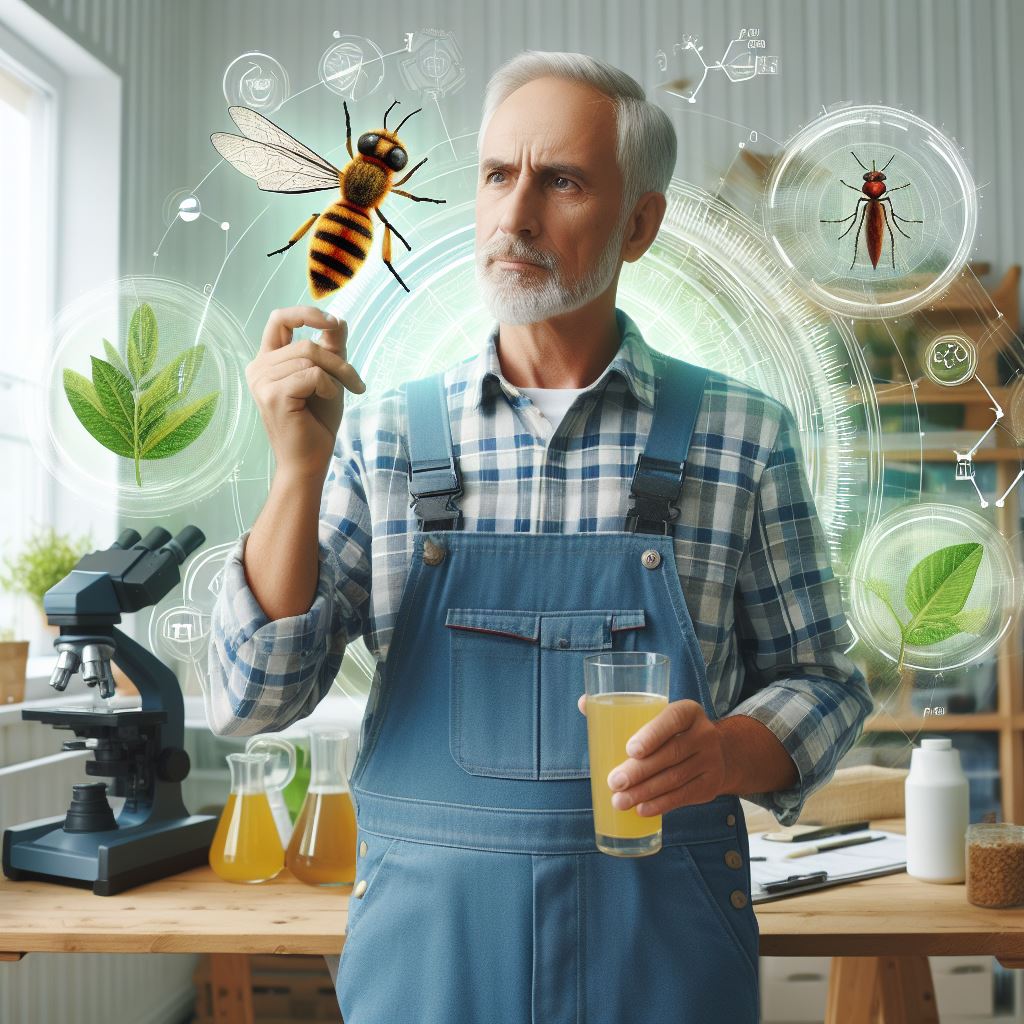Introduction
Let’s explore integrated pest management: Biodiversity booster.
Integrated Pest Management (IPM) is a holistic and sustainable approach to controlling pests in agriculture.
It emphasizes the use of multiple pest management tactics to reduce reliance on chemical pesticides.
Biodiversity, the variety of life forms in an ecosystem, is a fundamental component of IPM.
Biodiversity is essential for agricultural systems as it promotes natural pest control by maintaining a diverse range of predators, parasites, and beneficial organisms.
By encouraging a rich and varied ecosystem, farmers can reduce the dependence on chemical interventions while achieving effective pest control.
Additionally, biodiversity enhances the resilience of agricultural landscapes to climate change and other environmental pressures.
The purpose of this blog post is to raise awareness about the critical role of biodiversity in IPM.
It aims to highlight the benefits of integrating biodiversity conservation strategies into agricultural practices.
By adopting IPM techniques that prioritize biodiversity, farmers can not only protect their crops but also contribute to the preservation of a healthy and balanced agricultural ecosystem.
Throughout this blog section, we will explore various aspects of IPM and how they relate to biodiversity.
We will discuss the importance of habitat conservation, the role of native plants, and the promotion of beneficial insects.
By understanding and implementing these practices, farmers can harness the power of biodiversity to boost their pest management efforts and ensure long-term agricultural sustainability.
In short, Integrated Pest Management (IPM) and biodiversity go hand in hand.
Moreover, by incorporating biodiversity into agricultural systems, farmers can enhance pest control, reduce environmental impacts, and create a more resilient and sustainable food production system.
Transform Your Agribusiness
Unlock your farm's potential with expert advice tailored to your needs. Get actionable steps that drive real results.
Get StartedThis blog post aims to inspire and educate readers about the significance of integrating biodiversity into IPM strategies.
Together, we can work towards harmonizing agricultural practices with nature, ultimately benefiting both farmers and the environment.
Understanding Integrated Pest Management
The IPM approach
Integrated Pest Management (IPM) is a sustainable and environmentally-friendly approach to pest control that aims to minimize the use of harmful chemicals and promote biodiversity.
It involves a holistic strategy that combines different practices for effective pest management.
Components of IPM
IPM consists of four main components that work together to ensure long-term pest control without causing harm to the environment:
Pest identification and monitoring
The first step in IPM is accurately identifying the pests present in the area and assessing their population levels.
This involves regular monitoring and observation, using traps, and collecting samples for analysis.
Understanding the pest species and their behavior is crucial in developing effective control strategies.
Prevention and cultural practices
Prevention plays a key role in IPM. It focuses on implementing cultural practices such as crop rotation, habitat manipulation, and proper sanitation to create an environment that is less favorable for pests.
By eliminating pest-friendly conditions, the chances of infestations are significantly reduced, minimizing the need for
chemical interventions.
Biological control
Biological control is the use of natural enemies, such as predators, parasites, or pathogens, to regulate pest populations.
Beneficial insects like ladybugs and spiders are introduced to agricultural fields to prey on pests, thereby reducing damage and the need for synthetic chemicals.
This method encourages biodiversity and helps maintain a balanced ecosystem.
Chemical control (last resort)
Chemical control is considered a last resort in IPM and should only be used when necessary.
If pest populations cannot be managed through non-chemical means, carefully selected pesticides are used as a targeted intervention.
This approach ensures that only the pests are affected while minimizing the impact on beneficial organisms and the surrounding environment.
In fact, integrated Pest Management aims to strike a balance between pest control and the
preservation of a healthy environment.
By adopting this approach, farmers and gardeners can protect their crops while minimizing the negative impact on beneficial insects, wildlife, and the overall ecosystem.
IPM is a sustainable and responsible way to manage pests and promote biodiversity in our agricultural landscapes.
Read: Bee-Friendly Farming: A Must for Diversity
The Role of Biodiversity in IPM
The connection between biodiversity and pest control
Biodiversity plays a crucial role in Integrated Pest Management (IPM) by influencing pest control outcomes.
The presence of diverse plant species creates a complex ecosystem that naturally regulates pest populations.
A variety of plant species provides habitat and food for beneficial organisms that can control pests.
Benefits of biodiversity for farmers
Natural pest control
Biodiversity promotes the presence of beneficial insects, birds, and other organisms that prey on pests.
Showcase Your Farming Business
Publish your professional farming services profile on our blog for a one-time fee of $200 and reach a dedicated audience of farmers and agribusiness owners.
Publish Your ProfileThese organisms can effectively control pest populations, reducing the need for synthetic pesticides.
Nutrient cycling and soil health
Diverse plant species improve soil fertility and structure, enhancing nutrient cycling and soil health.
Healthy soils support vigorous crop growth and can better withstand pest attacks.
Examples of how biodiversity can enhance IPM outcomes
Intercropping and companion planting
Planting multiple crops together or in close proximity increases biodiversity.
Different plant species can repel pests, attract beneficial insects, or enhance soil conditions.
For example, interplanting marigolds with vegetables can deter pests like aphids and nematodes.
Creating habitat for beneficial organisms
Farmers can create specific habitats that attract beneficial insects, birds, or predatory mammals.
These organisms contribute to pest control by feeding on pests or disrupting their lifecycle.
For instance, constructing birdhouses to attract insect-eating birds can reduce pest populations.
Crop rotation and diversification
Rotating crops and diversifying plant species in a field disrupts the life cycles of pests.
Pests that rely on a specific crop are unable to thrive when their preferred host is not present.
By incorporating different plant families and avoiding continuous monoculture, pest pressure decreases.
Biodiversity is a valuable tool for farmers practicing IPM as it offers numerous benefits.
The presence of diverse plant species stimulates natural pest control mechanisms, reducing reliance on chemical pesticides.
In addition, biodiversity enhances soil health and nutrient cycling, promoting sustainable agricultural practices.
By intercropping, creating beneficial habitat, and implementing crop rotation, farmers can maximize the benefits of biodiversity in IPM.
In essence, biodiversity is a vital component of Integrated Pest Management.
Through the establishment of diverse ecosystems, farmers can harness the power of natural pest control.
The interplay between plant species, beneficial organisms, and soil health creates a sustainable and resilient agricultural system.
By embracing biodiversity, farmers can effectively manage pests while minimizing environmental impacts and promoting long-term sustainability.
Read: Hedgerows: Highways of Biodiversity

Supporting Biodiversity in Agriculture
Creating habitat for beneficial organisms
Maintaining hedgerows and field margins
Hedgerows and field margins provide shelter, food, and nesting sites for beneficial insects and birds.
Establishing cover crops
Cover crops help prevent soil erosion, improve soil health, and provide habitat for beneficial insects.
Installing bee-friendly habitats
Creating flower-rich areas and providing nesting sites can support pollinators like bees and butterflies.
Reducing pesticide usage
Targeted and selective pesticide application
By only targeting specific pests when needed, farmers can minimize pesticide use and protect beneficial organisms.
Using organic and biodegradable pest control products
Choosing organic and biodegradable pest control options promotes the health of beneficial organisms and reduces negative environmental impacts.
Promoting sustainable farming practices
Soil conservation and organic matter management
Practicing no-till farming, using cover crops, and maintaining soil organic matter enhances soil quality and supports diverse soil organisms.
Water conservation and responsible irrigation
Efficient irrigation practices reduce water usage, which protects aquatic ecosystems and the organisms that depend on them.
Adopting integrated pest management practices in agriculture not only helps control pest populations but also encourages biodiversity.
Creating habitat for beneficial organisms
By creating habitats for beneficial organisms, farmers can promote a healthy ecosystem within their fields.
Maintaining hedgerows and field margins is an effective way to support biodiversity.
These areas act as refuge for beneficial insects and birds, which in turn prey on pests. By preserving and enhancing these natural habitats, farmers can reduce the need for synthetic pesticides.
Another approach to supporting biodiversity is by establishing cover crops.
Cover crops provide multiple benefits, such as preventing soil erosion, improving soil fertility, and attracting beneficial insects.
Choosing cover crop species that bloom and provide nectar can also support pollinators.
Installing bee-friendly habitats is crucial for the conservation of pollinators like bees and butterflies.
Creating flower-rich areas and providing nesting sites can help these important pollinators thrive.
By promoting their well-being, farmers ensure the pollination of crops and biodiversity conservation.
Reducing pesticide usage
Reducing pesticide usage is a key aspect of integrated pest management. Instead of continuously applying pesticides, farmers should adopt a targeted and selective approach.
By monitoring pest populations and intervening only when necessary, farmers can minimize pesticide use and avoid harm to beneficial organisms.
Showcase Your Farming Business
Publish your professional farming services profile on our blog for a one-time fee of $200 and reach a dedicated audience of farmers and agribusiness owners.
Publish Your ProfileChoosing organic and biodegradable pest control products further supports biodiversity.
These products are less harmful to beneficial organisms and have lower environmental impacts.
By prioritizing the use of eco-friendly alternatives, farmers can contribute to a healthier and more sustainable agricultural system.
Promoting sustainable farming practices
Promoting sustainable farming practices is vital for biodiversity conservation. Soil conservation techniques, such as no-till farming and cover cropping, protect the soil from erosion and enhance its fertility.
These practices ensure the survival of diverse soil organisms that play a crucial role in maintaining soil health.
Efficient water management also contributes to biodiversity conservation.
By implementing responsible irrigation practices and using water conservatively, farmers protect aquatic ecosystems and the organisms living in them.
Conserving water resources and minimizing water pollution are essential for maintaining biodiversity in agricultural landscapes.
In general, integrated pest management practices that support biodiversity are essential for sustainable agriculture.
By creating habitats for beneficial organisms, reducing pesticide usage, and promoting sustainable farming practices, farmers can maintain a healthy ecosystem within their fields.
Biodiversity conservation is not only crucial for environmental health but also for the long-term productivity and resilience of agricultural systems.
Read: Cover Crops: Guardians of Biodiversity
Success Stories: Biodiversity and IPM in Action
In this section, we will explore some success stories where Integrated Pest Management (IPM) techniques and the promotion of biodiversity have been effectively utilized.
These real-life examples demonstrate the positive impact of IPM and biodiversity on pest control and agricultural sustainability.
Examples of successful IPM programs
- The use of trap crops in pest management: Many IPM programs have successfully employed trap crops, which are specific plants grown to attract pests away from the main crop. By diverting pests to these trap crops, farmers can protect their primary crops.
- Enhancing natural enemy populations through conservation: Another successful IPM strategy is the conservation and enhancement of natural enemies of pests. By providing habitats and resources that support natural enemies, such as beneficial insects, birds, and bats, farmers can reduce reliance on pesticides.
IPM programs that incorporate these techniques have demonstrated significant reductions in pest damage, enhanced crop health, and increased overall sustainability.
Case studies showcasing the benefits of biodiversity in IPM
- Increased crop yields and reduced pesticide use: Numerous case studies have revealed that integrating biodiversity into IPM practices leads to higher crop yields while reducing the need for chemical pesticides. By promoting biodiversity through diversified planting and preserving natural habitats, farmers can achieve balanced ecosystems that naturally suppress pests.
- Long-term sustainability and resilience: Biodiversity-based IPM approaches have proven to be more sustainable and resilient in the face of changing environmental conditions and pest pressures. By creating diverse agroecosystems, farmers can withstand potential disruptions and adapt to challenges, ensuring the long-term viability of their operations.
A vineyard in California’s Central Valley
For example, a study conducted in a vineyard in California’s Central Valley implemented a comprehensive IPM program that emphasized biodiversity.
By adopting strategies like planting cover crops, maintaining hedgerows, and releasing natural enemies, the vineyard managed to reduce pest damage by 95% and decrease insecticide use by 98%.
This success story highlights the effectiveness of IPM and the significant role that biodiversity plays in pest management.
Rice cultivation in Indonesia
Another case study from Indonesia showed that farmers who implemented IPM practices in rice cultivation achieved increased yields, reduced pest damage, and reduced pesticide dependence.
By reducing their pesticide use, these farmers not only saved costs but also protected their health and the environment.
This demonstrates the multiple benefits of biodiversity-based IPM approaches in promoting sustainable agriculture and improving farmers’ livelihoods.
In summary, these success stories serve as inspiring examples of how Integrated Pest Management and the integration of biodiversity can revolutionize pest control and agricultural practices.
By harnessing the power of nature, farmers can achieve effective pest management, safeguard the environment, and ensure long-term sustainability.
These stories offer hope and motivation for the widespread adoption of IPM strategies and biodiversity promotion in agricultural systems worldwide.
Read: Natural Pest Control: A Biodiversity Ally
Conclusion
Integrated pest management (IPM) is crucial for sustainable agriculture and environmental conservation.
Biodiversity plays a significant role in boosting IPM outcomes by providing natural pest control services.
Farmers are encouraged to adopt biodiversity-friendly practices to enhance the effectiveness of IPM.
Embracing IPM and biodiversity-friendly farming practices is essential for the future of sustainable agriculture.
Implementing these strategies will not only minimize the use of harmful pesticides but also promote a healthier ecosystem.
Farmers, as stewards of the land, have a responsibility to preserve biodiversity and protect the environment for future generations.
Moreover, by integrating biodiversity into their farming systems, they can contribute to the conservation of beneficial insects, birds, and other organisms.
The result would be a more balanced and resilient ecosystem that can better withstand pest outbreaks.
To achieve this, farmers can implement measures such as planting hedgerows, cover crops, and creating habitat for natural enemies of pests.
Moreover, adopting agroforestry practices and reducing the reliance on monocultures will have long-term benefits for both agriculture and biodiversity.
Embracing biodiversity-friendly practices not only enhances the effectiveness of IPM but also fosters a more sustainable and resilient farming system.
Therefore, it is imperative for farmers to take the lead in transitioning towards a more biodiversity-centric approach for pest management.
By doing so, they can contribute towards healthier agricultural landscapes and a more sustainable future for the planet.
The time for action is now, and together, we can create a harmonious balance between agricultural production and nature conservation.




